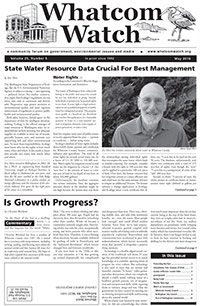by Eric Hirst
The Washington State Department of Ecology, like the U.S. Environmental Protection Agency, is subject to strong — and opposing — political forces. Pro-market conservatives argue that Ecology’s regulations are too strict, raise costs to consumers and destroy jobs. Progressives urge greater attention to environmental quality and more vigorous enforcement of regulations to protect public health and environmental quality.
Both sides, however, should agree on the importance of data for intelligent decision-making. Ecology is the official manager of water resources in Washington state. Its responsibilities include ensuring that adequate supplies are available to meet out-of-stream, generally human, uses, and instream uses supporting fish and other environmental uses. To meet these responsibilities, Ecology must know who has the rights to how much water, when and where. It also needs to know who actually uses water, how much, when and where.
Water Rights (1)
According to the Governor’s Office for Regulatory Innovation and Assistance:
The waters of Washington State collectively belong to the public and cannot be owned by any one individual or group. Instead, individuals or groups may be granted rights to use them. A water right is a legal authorization to use a predefined quantity of public water for a designated purpose. This purpose must qualify as a beneficial use. Beneficial use involves the application of a reasonable quantity of water to a non-wasteful use, such as irrigation, domestic water supply, or power generation, to name a few.
State law requires most users of public waters to receive approval from the state — a permit or certificate — before using water.
Ecology’s database of water rights includes about 6,600 claims, permits and certificates for Whatcom County homes, commerce, industry and agriculture. The total of all water rights far exceeds actual water use, by a factor of 3.1, 317,000 vs. 101,000 acre-feet. Water rights for irrigation exceed actual water use for irrigation by a factor 1.8. (An “acre foot” is the amount of water to cover one acre of land to the depth of one foot, or about 326,000 gallons).
Unfortunately, the database contains two serious omissions. First, the aggregate amounts shown in the database might be too high because the system does not show the relationships among individual rights that encompass the same water, which leads to double-counting. For example, consider a farmer with the right to 200 acre-feet that can be applied to a particular 100-acre piece of land. Over time, the farmer converts his/her irrigation system to a more efficient one and could now use the same amount of water to irrigate an additional 50 acres. The farmer submits a change application to Ecology, and Ecology issues a new certificate that allows, say, 75 acre-feet to be used on the new 50 acres. The database, unfortunately, now shows two certificates with a total of 275 acre-feet of rights, even though the “new” 75 acre-feet is a reassignment of some of the “old” 200 acre-feet.
Second, in about 75 percent of cases, the claim, permit or certificate shows an instantaneous water right (defined as gallons per minute flowrate) but no annual water right (defined as the total annual water use). However, in an unknown number of these cases, Ecology has interpreted the instantaneous water right as implying an annual water right. For example, an Ecology staffer might examine a farmer’s acreage to determine the type of crop grown, water requirements for that crop and acreage irrigated. On the basis of these site-specific characteristics, Ecology would then provide a certain annual right, although this annual right is not shown in the database. My simple calculation suggests that these cases might add about 124,000 acre-feet to the Whatcom County total, almost 40 percent of the “official” total.
Metered Water-Use Data (2)
Water use data, rather than estimates, could be enormously helpful in many ways. These include:
- defining current water use,
- showing how water use varies among different users and over time,
- quantifying Native American tribal treaty rights,
- quantifying and resolving issues related to unpermitted water use,
- quantifying the benefits of different water-efficiency technologies and operating practices, and
- assessing the pros and cons of expanding water supplies and increasing efficiency of water use.
The only way to obtain such data is through metering, which in most cases is required by state law.
Ecology recognizes the value of metered water-use data:
“Measuring water use benefits the public in many ways, such as:
- Providing a tool for ensuring compliance with water rights.
- Supplying information for water resource planning and management.
- Informing water users how much water they are using, and
- Helping to better manage a limited natural resource.” (3)
Ecology is required by state law, a court order and its own rules to collect metered water-use data from most users. Unfortunately, my experience shows that these data, at least for Whatcom County, are not available to the public. Ecology staff told me that the agency has not written any reports or papers using these data, which suggests that it does little or no analysis.
Ecology officials could not even tell me the number of farms for which it had data for each of the past few years, even though it has been collecting these data for more than a decade.
Data from three golf courses hints at how valuable these data could be. Nine years of water-meter data show strong August peaks in water use, with July and September usage about 40 percent below the August peak. Annual water use at these golf courses ranged from five to 10 inches.
Conclusions
Ecology’s Water Resources Program website says: “We are working closely with Washington communities and their citizens to provide effective water management. Historically, Washington residents have enjoyed an abundance of water, but water availability is no longer a luxury. We are committed to meeting current water needs and ensuring future water availability for people, fish and the natural environment.” (4)
Ecology, however, cannot meet these goals without reliable data on water rights and water use. The agency must also make its data and analyses available to the public, so we can understand the loss of this “luxury” and help determine how to live with water scarcity.
An accurate accounting of water rights is needed for proper allocation of water during droughts and other shortages while honoring the Lummi Nation’s 1855 Point Elliott treaty rights. Their right to instream flows to support abundant salmon and out-of-stream reservation use predates and is therefore more senior than the rights assigned by Ecology. Because these data on water rights are so important Ecology should:
- Provide better documentation, all in one place, so users can understand what the data mean.
- Remove or clearly identify the double-counting among water rights.
- Make explicit the annual water rights that are implied by instantaneous water rights but not shown in the current database. A straightforward reading of the database as it now exists may miss up to 30 percent of total annual rights.
As noted above, data on actual as opposed to estimated water use is essential for many reasons. This is especially true for the agricultural sector, which is by far the largest summer water user in Whatcom County with about two-thirds of total water use.
Ecology should:
- Increase the amount and effectiveness of resources — people, software, and hardware — devoted to these tasks that are vital to resolution of our many water issues.
- Replace its existing database with a modern system that allows easy import, export and analysis of the data.
- Deploy automated meter-reading systems to record and transfer to Ecology water-use data from farmers and others to improve the timeliness of data reporting and to largely eliminate data recording and reporting errors.
- Analyze the data to address the subjects raised here and publish reports to inform the public on our water-supply and -efficiency issues.
Ecology in fact recognizes the limitations in its current approach to managing these data. Its “Water Resources Program Strategic Plan for 2016-2020” calls for the agency to “Report water resource metering data,” and to “Improve metering database and transition to electronic submittal of metering data.” (5)
Endnotes
(1) For more detail, see E. Hirst, Whatcom Water Rights and Applications: Insights from Ecology’s Data, Feb. 2016, EricHirst@comcast.net.
(2) For more detail, see E. Hirst, Ecology’s Role in Metering Whatcom Water Use, Feb. 2016, EricHirst@comcast.net.
(3) Ecology, “Measuring Water Use,” http://www.ecy.wa.gov/programs/wr/measuring/measuringhome.html.
(4) http://www.ecy.wa.gov/programs/wr/wrhome.html
(5) http://www.ecy.wa.gov/programs/wr/wrac/images/pdf/WR2016-2020StrategicPlan.pdf .
___________________________________________
Eric Hirst moved to Bellingham in 2002. He has a Ph.D. in engineering from Stanford University, taught at Tuskegee Institute (a black college in Alabama) for two years, and then for 30 years worked at the Oak Ridge National Laboratory as a policy analyst on energy efficiency and the structure of the electricity industry. Eric spent the last eight years of his career as a consultant.





























